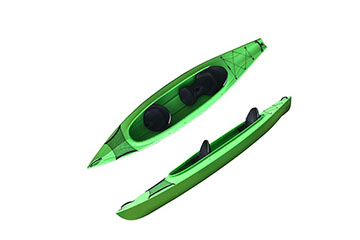The Introduction Of Kayak
The Introduction Of Kayak
Kayak suppliers will share this article with you.
Kayak equipment
Essential kayaking equipment: Whoever supplies the boat should also provide the following items:
Coast Guard approval
Appropriate PFD (Personal Flotation Device)
Paddle (Make sure they check that the size fits you)
Bilge pump
Blowout skirt (optional on warm, calm days)
Appropriate clothing: Bring the following items for warm weather, warm water outings:
Bathing suit, shorts(Non-cotton and non-binding)
Short or long sleeves
Neoprene shoes
Sun-shielding hat
Lightweight fleece jacket or vest(Depending on the weather)
Spray coat, or raincoat and the trousers(Depending on the weather)
If the ambient temperature is below 60 F (especially water), a wetsuit is also required.
Personal Items: If you know your top 10 essentials, many of them should be familiar:
Plenty of water
Snacks, high energy, longer lunchtime
Sunscreen, lip balm, and sunglasses (with retainers)
First aid kit
Signal whistle
Watch (so you can give yourself plenty of time to recover from your life)
Headlight (in case you're too slow to turn back)
Drybag (for things you don't want to get wet)
How to adjust the kayak
The adjusted kayak will be more stable and comfortable rowing. Make adjustments while the ship is on land and pay attention to three points of contact:
Press your hips against the back of your back. If your boat allows you to fine-tune the Angle of the seat or backrest, perform the most comfortable operation. However, for balance and strength, you want to sit more upright.
Place the sole of the foot on the nail; Then check for any slight bending of the knee. Most foot studs can be adjusted by tilting and sliding along the track to a preset stop point. It is usually easier to slide nails out of the boat.
Make sure the bent knees are in firm contact with each side of the cockpit. This helps you control the boat's left and right movements as you paddle. Your workout should be comfortable, but not so tight that you can't get out when you roll over.

How do you start a kayak?
Most trips are launched from a gradually sloping coastline. Take care to avoid towing the hull, especially on the rock, sandy, or cement surfaces:
Find a friend to help you get the ship to your destination. Place it in shallow water perpendicular to the shoreline. (If you're going into a river or have a long kayak, a parallel launch might be better.) For the vertical launch, the bow should be backed against the opposite bank, while the stern should float close to shore (but fully ashore).
Place one of the blades below the deck in front of the cockpit. (The shaft can be extended sideways like a leg.)
Stand in a kayak and cross the cockpit.
Grab the cockpit and place your hips on the cockpit seat, then lift your legs and slide your feet into the cockpit.
Slide your hips firmly back into the seat and place your feet comfortably on the pegs.
Grab your oar and use it to propel the kayak over the waves and stern. Then, if there is, please tie on your spray skirt.
When it's time to get off the boat, just row it into the launch position, set the legs, and reverse steps until you're in the kayak again.










